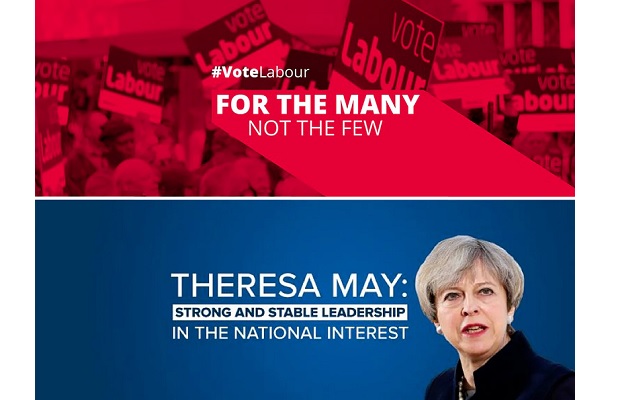After last week’s general election, new research indicates that The Conservative Party ran an “ineffective” social media campaign that failed to attract new voters and did not energise its traditional base.
The shock election result saw the Conservatives getting the most votes but losing seats and failing to win a majority.
By contrast Labour gained seats and it’s proportion of the vote grew 9.6% in Thursday’s poll, marking the biggest vote swing to any party since Clement Attlee shortly after the Second World War.
Jeremy Corbyn has just increased Labour’s share of the vote more than any other leader in any other election since Attlee in 1945 pic.twitter.com/CwcHzHZ04q
— Fraser Nelson (@FraserNelson) 9 June 2017
The study, from We Are Social, revealed that the Labour Party increased its following by 61% across Facebook, Twitter and Instagram in the six weeks after the election was called.
By comparison, The Conservatives’ following rose by just 6% in the same period and research shows they targeted far too narrowly.
Alongside paid social media ads, it appears that Labour had huge organic share numbers in contrast with his rivals.
By contrast, even in the final hours of the campaign the Conservatives were using social media to target Labour marginals rather than defend its own vulnerable seats, many of which it went on to lose.
It seems that the Conservatives were relying heavily on tactics that won them a majority in the previous 2015 general election, when they were reported to have spend 10 times more than Labour on targeting swing constituencies with negative messages about rivals. However, it looks like digital media (and the political landscape) has evolved since then.
“The Conservatives and Theresa May really missed a trick over the past six weeks,” said Andre van Loon, research and insight director at We Are Social. “They would have seen the data as it came through and yet they didn’t change anything. They could have tried to be more appealing to young people from the start.”
He said that Theresa May’s core message of stability did not appear to play well with undecided voters, but Labour’s “engaging and social” posts performed better. “The ‘strong and stable’ message didn’t seem to attract any new support on social media,” he said.
Labour’s social strategy: More positive with a wider reach
The Conservative Party’s online strategy online appeared to be to target swing and new voters.
Separate data from Who Targets Me?, a website tool created to track political advertising on social media, indicates the Tories were promoting their online coverage largely to new audiences.
‘Who Targets Me?’ claimed people in just 205 constituencies saw adverts from the Conservatives. That was less than half the constituencies targeted by Labour.
Labour promoted its final “get out the vote” advert in 464 constituencies, whereas the Conservative equivalent was promoted in just 205, according to Who Targets Me?’s data. The figures, which comes from people who install a web plugin and therefore could contain biases, showed the Conservatives focused their attention on marginal seats.
Millions spent on “dark” Facebook ads
In the run-up to the campaign, reports had claimed that the Conservatives were using hyper-targeted “dark” adverts on Facebook to appeal to individual users in marginal constituencies.
Tories spent £1,200,000 on negative anti-Jeremy Corbyn social media adverts, filling Facebook, YouTube and Snapchat with adverts aimed at Jeremy Corbyn.
And an anti-Corbyn advert, paid for by the Conservatives, even became to the most-viewed political advert ever in the UK.
Yet young people overwhelmingly supported Labour despite the social media attacks on Mr Corbyn.
The Tories had used the firm Edmonds Elder just like they did under David Cameron in 2015.
The value of organic traffic
The cost of the targeted adverts, revealed by the Times, is in contrast with the Labour party.
Corbyn and his team courted social media with a policy-driven campaign. While organic groups like Grime4Corbyn, online comedians and meme makers cost Labour nothing but were effective.
See two examples below that got hundreds of thousands of organic views on Youtube and Facebook:
Speaking to the Times, Sam Jeffers, co-founder of Who Targets Me?, said: “The most obvious advantage Labour had was their focus on getting young people out to vote. If you contact young people with a positive message, you’re telling them that you care. The Tories didn’t do that.”
Labour also cast its net wider with its voter suppression ad about “dementia tax”, which Who Targets Me picked up in more than 200 constituencies. The Tories’ anti-Corbyn ad, focusing on his comments about shoot to kill, were seen in only about 100 seats.
On the actual day of the vote, Labour spent considerable money promoting its hashtag #forthemany on Twitter. Twitter is considered Labour’s online stronghold and while buying the rights to promote a single hashtag can cost as much as £50,000, the expense may have been worth it to rally the younger vote, which appears to have played a significant role in Labour’s performance.

